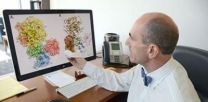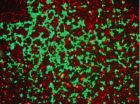(Press-News.org) Nanophotonics experts at Rice University have created a unique sensor that amplifies the optical signature of molecules by about 100 billion times. Newly published tests found the device could accurately identify the composition and structure of individual molecules containing fewer than 20 atoms.
The new imaging method, which is described this week in the journal Nature Communications, uses a form of Raman spectroscopy in combination with an intricate but mass reproducible optical amplifier. Researchers at Rice's Laboratory for Nanophotonics (LANP) said the single-molecule sensor is about 10 times more powerful that previously reported devices.
"Ours and other research groups have been designing single-molecule sensors for several years, but this new approach offers advantages over any previously reported method," said LANP Director Naomi Halas, the lead scientist on the study. "The ideal single-molecule sensor would be able to identify an unknown molecule -- even a very small one -- without any prior information about that molecule's structure or composition. That's not possible with current technology, but this new technique has that potential."
The optical sensor uses Raman spectroscopy, a technique pioneered in the 1930s that blossomed after the advent of lasers in the 1960s. When light strikes a molecule, most of its photons bounce off or pass directly through, but a tiny fraction -- fewer than one in a trillion -- are absorbed and re-emitted into another energy level that differs from their initial level. By measuring and analyzing these re-emitted photons through Raman spectroscopy, scientists can decipher the types of atoms in a molecule as well as their structural arrangement.
Scientists have created a number of techniques to boost Raman signals. In the new study, LANP graduate student Yu Zhang used one of these, a two-coherent-laser technique called "coherent anti-Stokes Raman spectroscopy," or CARS. By using CARS in conjunction with a light amplifier made of four tiny gold nanodiscs, Halas and Zhang were able to measure single molecules in a powerful new way. LANP has dubbed the new technique "surface-enhanced CARS," or SECARS.
"The two-coherent-laser setup in SECARS is important because the second laser provides further amplification," Zhang said. "In a conventional single-laser setup, photons go through two steps of absorption and re-emission, and the optical signatures are usually amplified around 100 million to 10 billion times. By adding a second laser that is coherent with the first one, the SECARS technique employs a more complex multiphoton process."
Zhang said the additional amplification gives SECARS the potential to address most unknown samples. That's an added advantage over current techniques for single-molecule sensing, which generally require a prior knowledge about a molecule's resonant frequency before it can be accurately measured.
Another key component of the SECARS process is the device's optical amplifier, which contains four tiny gold discs in a precise diamond-shaped arrangement. The gap in the center of the four discs is about 15 nanometers wide. Owing to an optical effect called a "Fano resonance," the optical signatures of molecules caught in that gap are dramatically amplified because of the efficient light harvesting and signal scattering properties of the four-disc structure.
Fano resonance requires a special geometric arrangement of the discs, and one of LANP's specialties is the design, production and analysis of Fano-resonant plasmonic structures like the four-disc "quadrumer." In previous LANP research, other geometric disc structures were used to create powerful optical processors.
Zhang said the quadrumer amplifiers are a key to SECARS, in part because they are created with standard e-beam lithographic techniques, which means they can be easily mass-produced.
"A 15-nanometer gap may sound small, but the gap in most competing devices is on the order of 1 nanometer," Zhang said. "Our design is much more robust because even the smallest defect in a one-nanometer device can have significant effects. Moreover, the larger gap also results in a larger target area, the area where measurements take place. The target area in our device is hundreds of times larger than the target area in a one-nanometer device, and we can measure molecules anywhere in that target area, not just in the exact center."
Halas, the Stanley C. Moore Professor in Electrical and Computer Engineering and a professor of biomedical engineering, chemistry, physics and astronomy at Rice, said the potential applications for SECARS include chemical and biological sensing as well as metamaterials research. She said scientific labs are likely be the first beneficiaries of the technology.
"Amplification is important for sensing small molecules because the smaller the molecule, the weaker the optical signature," Halas said. "This amplification method is the most powerful yet demonstrated, and it could prove useful in experiments where existing techniques can't provide reliable data."
INFORMATION:
Study co-authors include Yu-Rong Zhen, Oara Neumann, Jared Day and Peter Nordlander, all of Rice. The research was supported by the Department of Defense, the Defense Threat Reduction Agency and the Robert A. Welch Foundation.
High-resolution IMAGES are available for download at:
http://news.rice.edu/wp-content/uploads/2014/07/0714_NATCOM-cutaway-lg.jpg
CAPTION: Rice's SECARS molecular sensor contains an optical amplifier made of four gold discs arranged in a diamond-shaped pattern. A two-coherent-laser setup amplifies the optical signatures of molecules in the center of the structure as much as 100 billion times.
CREDIT: Y. Zhang/Rice University
http://news.rice.edu/wp-content/uploads/2014/07/0714_NATCOM-Yu-lg.jpg
CAPTION: Yu Zhang
CREDIT: Jeff Fitlow/Rice University
A copy of the Nature Communications paper is available at:
http://www.nature.com/ncomms/2014/140714/ncomms5424/full/ncomms5424.html
Follow Rice News and Media Relations via Twitter @RiceUNews
Located on a 300-acre forested campus in Houston, Rice University is consistently ranked among the nation's top 20 universities by U.S. News & World Report. Rice has highly respected schools of Architecture, Business, Continuing Studies, Engineering, Humanities, Music, Natural Sciences and Social Sciences and is home to the Baker Institute for Public Policy. With 3,920 undergraduates and 2,567 graduate students, Rice's undergraduate student-to-faculty ratio is just over 6-to-1. Its residential college system builds close-knit communities and lifelong friendships, just one reason why Rice has been ranked No. 1 for best quality of life multiple times by the Princeton Review and No. 2 for "best value" among private universities by Kiplinger's Personal Finance.
Rice nanophotonics experts create powerful molecular sensor
Sensor amplifies optical signature of single molecules about 100 billion times
2014-07-15
ELSE PRESS RELEASES FROM THIS DATE:
SLU scientists hit 'delete': Removing regions of shape-shifting protein explains how blood clots
2014-07-15
ST. LOUIS – In results recently published in Proceedings of the National Academy of Sciences (PNAS), Saint Louis University scientists have discovered that removal of disordered sections of a protein's structure reveals the molecular mechanism of a key reaction that initiates blood clotting.
Enrico Di Cera, M.D., chair of the Edward A. Doisy department of biochemistry and molecular biology at Saint Louis University, studies thrombin, a key vitamin K-dependent blood-clotting protein, and its inactive precursor prothrombin (or coagulation factor II).
"Prothrombin is essential ...
New skin gel fights breast cancer without blood clot risk
2014-07-15
CHICAGO --- A gel form of tamoxifen applied to the breasts of women with noninvasive breast cancer reduced the growth of cancer cells to the same degree as the drug taken in oral form but with fewer side effects that deter some women from taking it, according to new Northwestern Medicine® research.
Tamoxifen is an oral drug that is used for breast cancer prevention and as therapy for non-invasive breast cancer and invasive cancer.
Because the drug was absorbed through the skin directly into breast tissue, blood levels of the drug were much lower, thus, potentially ...
Game theory model reveals vulnerable moments for cancer cells' energy production
2014-07-15
Cancer's no game, but researchers at Johns Hopkins are borrowing ideas from evolutionary game theory to learn how cells cooperate within a tumor to gather energy. Their experiments, they say, could identify the ideal time to disrupt metastatic cancer cell cooperation and make a tumor more vulnerable to anti-cancer drugs.
"The reality is that we still can't cure metastatic cancer that has spread from its primary organ and game theory adds to our efforts to attack the problem," says Kenneth J. Pienta, M.D., the Donald S. Coffey Professor of Urology at the Johns Hopkins ...
Adolescent males seek intimacy and close relationships with the opposite sex
2014-07-15
July 15, 2014 -- Teenage boys desire intimacy and sex in the context of a meaningful relationship and value trust in their partnerships, according to researchers at Columbia University's Mailman School of Public Health. The research provides a snapshot of the development of masculine values in adolescence, an area that has been understudied. Findings are online in the American Journal of Men's Health.
The researchers studied 33 males who ranged from 14 to 16 years of age to learn more about how their romantic and sexual relationships developed, progressed, and ended. ...
Fish oil supplements reduce incidence of cognitive decline, may improve memory function
2014-07-15
PROVIDENCE, R.I. –Rhode Island Hospital researchers have completed a study that found regular use of fish oil supplements (FOS) was associated with a significant reduction in cognitive decline and brain atrophy in older adults. The study examined the relationship between FOS use during the Alzheimer's Disease Neuroimaging Initiative (ADNI) and indicators of cognitive decline. The findings are published online in advance of print in the journal Alzheimer's & Dementia.
"At least one person is diagnosed every minute with Alzheimer's disease (AD) and despite best efforts, ...
Brain responses to emotional images predict PTSD symptoms after Boston Marathon bombing
2014-07-15
The area of the brain that plays a primary role in emotional learning and the acquisition of fear – the amygdala – may hold the key to who is most vulnerable to post-traumatic stress disorder.
Researchers at the University of Washington, Boston Children's Hospital, Harvard Medical School and Boston University collaborated on a unique opportunity to study whether patterns of brain activity predict teenagers' response to a terrorist attack.
The team had already performed brain scans on Boston-area adolescents for a study on childhood trauma. Then in April 2013 two bombs ...
Study finds unintended consequences of raising state math, science graduation requirements
2014-07-15
WASHINGTON, D.C., July 15, 2014 ─ Raising state-mandated math and science course graduation requirements (CGRs) may increase high school dropout rates without a meaningful effect on college enrollment or degree attainment, according to new research published in Educational Researcher (ER), a peer-reviewed journal of the American Educational Research Association.
VIDEO: Co-authors Andrew D. Plunk and William F. Tate discuss key findings. https://www.youtube.com/watch?v=jwxh1gj-T1M&feature=youtu.be
"Intended and Unintended Effects of State-Mandated High School ...
BUSM study: Obesity may be impacted by stress
2014-07-15
Using experimental models, researchers at Boston University School of Medicine (BUSM) showed that adenosine, a metabolite released when the body is under stress or during an inflammatory response, stops the process of adipogenesis, when adipose (fat) stem cells differentiate into adult fat cells.
Previous studies have indicated adipogenesis plays a central role in maintaining healthy fat homeostasis by properly storing fat within cells so that it does not accumulate at high levels in the bloodstream. The current findings indicate that the body's response to stress, potentially ...
Team studies immune response of Asian elephants infected with a human disease
2014-07-15
CHAMPAIGN, Ill. — Mycobacterium tuberculosis, the organism that causes tuberculosis in humans, also afflicts Asian (and occasionally other) elephants. Diagnosing and treating elephants with TB is a challenge, however, as little is known about how their immune systems respond to the infection. A new study begins to address this knowledge gap, and offers new tools for detecting and monitoring TB in captive elephants.
The study, reported in the journal Tuberculosis, is the work of researchers at the University of Illinois Zoological Pathology Program (ZPP), a division of ...
Protein's 'hands' enable bacteria to establish infection, research finds
2014-07-15
MANHATTAN — When it comes to infecting humans and animals, bacteria need a helping hand.
Kansas State University biochemists have found the helping hand: groups of tiny protein loops on the surface of cells. These loops are similar to the fingers of a hand, and by observing seven individual loops on the surface of E. coli bacterial cells, the researchers found that the loops can open or close to grab iron in the environment.
"These structures are like small hands on the surface of bacterial cells," said Phillip Klebba, principal investigator and professor and head of ...
LAST 30 PRESS RELEASES:
Automatic label checking: The missing step in making reliable medical AI
Low daily alcohol intake linked to 50% heightened mouth cancer risk in India
American Meteorological Society announces Rick Spinrad as 2026 President-Elect
Biomass-based carbon capture spotlighted in newly released global climate webinar recording
Illuminating invisible nano pollutants: advanced bioimaging tracks the full journey of emerging nanoscale contaminants in living systems
How does age affect recovery from spinal cord injury?
Novel AI tool offers prognosis for patients with head and neck cancer
Fathers’ microplastic exposure tied to their children’s metabolic problems
Research validates laboratory model for studying high-grade serous ovarian cancer
SIR 2026 delivers transformative breakthroughs in minimally invasive medicine to improve patient care
Stem Cell Reports most downloaded papers of 2025 highlight the breadth and impact of stem cell research
Oxford-led study estimates NHS spends around 3% of its primary and secondary care budget on the health impacts of heat and cold in England
A researcher’s long quest leads to a smart composite breakthrough
Urban wild bees act as “microbial sensors” of city health.
New study finds where you live affects recovery after a hip fracture
Forecasting the impact of fully automated vehicle adoption on US road traffic injuries
Alcohol-related hospitalizations from 2016 to 2022
Semaglutide and hospitalizations in patients with obesity and established cardiovascular disease
Researchers ‘listen in’ to embryo-mother interactions during implantation using a culture system replicating the womb lining
How changing your diet could help save the world
How to make AI truly scalable and reliable for real-time traffic assignment?
Beyond fragmented markets: A new framework for efficient and stable ride-pooling
Can shape priors make road perception more reliable for autonomous driving?
AI tracks nearly 100 years of aging research, revealing key trends and gaps
Innovative techniques enable Italy’s first imaging of individual trapped atoms
KIER successfully develops Korea-made “calibration thermoelectric module” for measuring thermoelectric device performance
Diversifying US Midwest farming for stability and resilience
Emphasizing immigrants’ deservingness shifts attitudes
Japanese eels, climate change, and river temperature
Pusan National University researchers discover faster, smarter heat treatment for lightweight magnesium metals
[Press-News.org] Rice nanophotonics experts create powerful molecular sensorSensor amplifies optical signature of single molecules about 100 billion times




